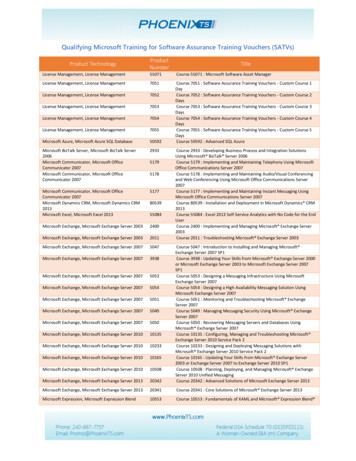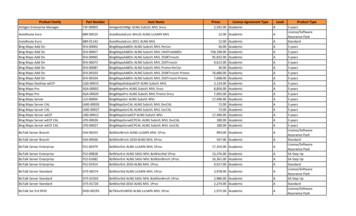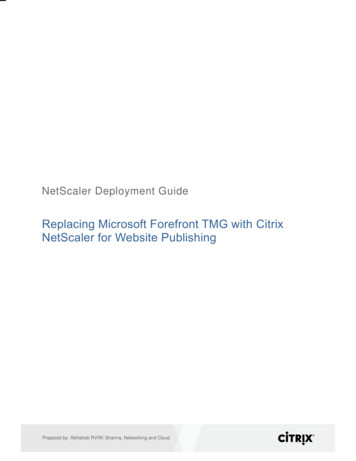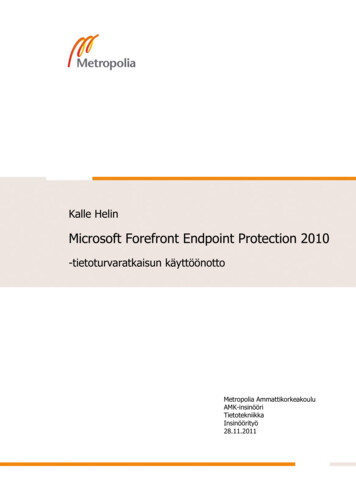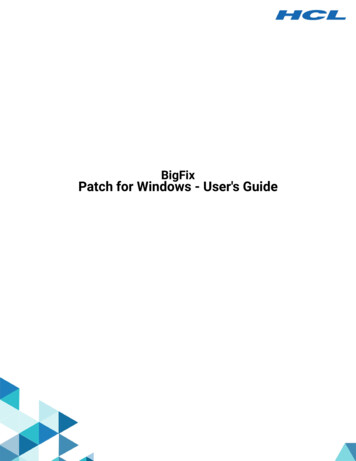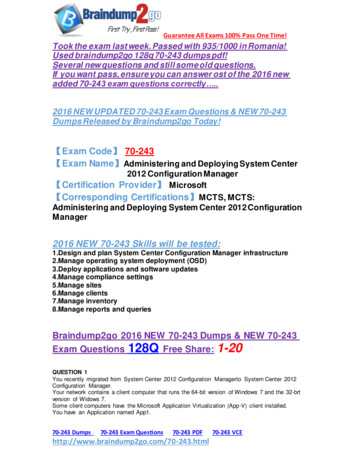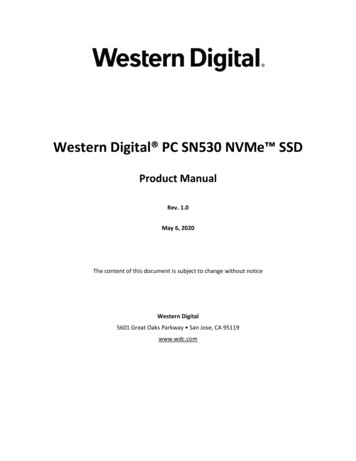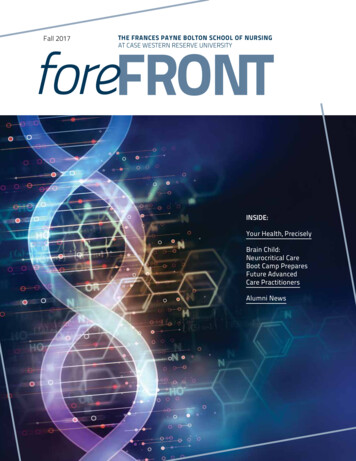
Transcription
foreFRONTFall 2017THE FRANCES PAYNE BOLTON SCHOOL OF NURSINGAT CASE WESTERN RESERVE UNIVERSITYINSIDE:Your Health, PreciselyBrain Child:Neurocritical CareBoot Camp PreparesFuture AdvancedCare PractitionersAlumni News
foreFRONTFall 2017conTENTSTHE FRANCES PAYNE BOLTON SCHOOL OF NURSINGAT CASE WESTERN RESERVE UNIVERSITYAbout ForefrontThis publication is produced twice a year for the alumni andfriends of the Frances Payne Bolton School of Nursing atCase Western Reserve University. The Forefront mission is toinform readers about the school’s excellence in nursing science,education and practice and how it impacts daily lives.Frances Payne Bolton School of NursingMary E. Kerr, PhD, RN, FAAN (GRS ’91)Dean and the May L. Wykle Endowed ProfessorSusan Frey, MAFISAssistant Dean for Finance, Administration andInformation TechnologyShirley M. Moore, PhD, RN, FAAN (GRS’79, NUR’91, GRS’93)Associate Dean for ResearchDavid A. PrattAssociate Dean for Development and Alumni Affairs8Mary F. Terhaar, DNSc, RN, FAANAssociate Dean for Academic AffairsEditorHelen Jones-Toms (MNO ’97)Director of Marketing and CommunicationsAssociate EditorKim Cornuelle-MarksAssistant Director of MarketingAssistant EditorMichelle KoskiAssistant Manager, Communications & MarketingArt DirectorSue HarrisDesign Director, Blue Star Design18DEPARTMENTSFEATURES818Your Health,PreciselyBrain Child:Neurocritical CareBoot Camp PreparesFuture Advanced CarePractitioners1Dean’s Letter2Bricks & Benches23Alumni News24Giving Back tothe Beginning26Class Notes30In Memoriam32 Alumni SpotlightWritersMichelle Koski, Helen Jones-Toms, Daniel Robinson, MichaelScott, Michelle Simakis, Jessica UllianPhotographersMichelle Koski, Roger Mastroianni, Daniel Milner,Thinkstock Photo, Gary YasakiEditorial AssistantsMegan Bell, Annika Liljegren, Margo SwannSend your comments and suggestionsfor future stories toOffice of Marketing and CommunicationsFrances Payne Bolton School of NursingCase Western Reserve University10900 Euclid Ave.Cleveland, OH 44106-4904fpbmarketing@case.eduVisit us at nursing.case.eduor call 216.368.4700.
nursing.case.edu 1dean’sLETTERDear Alumni and Friends:Last summer I invited nurse executives from some of our nation’s largest hospital systems tocampus to discuss the challenges they face in the health care C-suite. Topics ranged from newsites to deliver care, to new individualized treatments, to the importance of patient quality andsafety and more.This kind of dialogue is a testament to the ability of the Frances Payne Bolton School of Nursingto anticipate the needs of our students, our patients, and our profession. Our willingness toquestion and innovate helps us define the future of health care.You can see this in the cover story on page 8, “Your Health, Precisely.” It introduces you to fiveof our scientists who work on the leading edge of the precision health revolution. They areincorporating new techniques and technologies to deliver better patient-centered care.You also see it in the story, “Brain Child: Neurocritical Care Boot Camp Prepares Future AdvancedCare Practitioners,” found on page 18. In collaboration with the MetroHealth System, FPBdeveloped a unique two-day training program for this high-tech, high-touch and high-adrenalinesetting.Our new transformative home at the Health Education Campus is another opportunity for theschool to invent the future. Faculty, staff, students and I are working together to develop theschool’s vision after our June 2019 move. However, I have realized that the HEC timeline and mypersonal plans for retirement are not congruent. I feel it is vital to have continuity of leadershipwhen we execute and nurture that vision, once we are in our new surroundings.With that in mind, I felt it was in the best interest of the school to accelerate my plans. I willstep down as dean at the end of the academic year, but remain a resource for the transition andcontinue to serve on faculty. I am proud to say that my successor will arrive to find a healthy,vibrant school in a new world-class facility, with all of the programs fully accredited, our NIHresearch dollars at record levels, and surrounded by amazing students, faculty, staff and alumni.I deeply appreciate having the privilege of serving as dean of one of the greatest schools ofnursing in the world. Thank you for your support over the past seven years.Sincerely,Mary E. Kerr, PhD, RN, FAAN (GRS’91)Dean and the May L. Wykle Endowed Professor
2 Case Western Reserve University Frances Payne Bolton School of Nursing&bricks benchesFIGHTING LEAD POISONING: FPB SCHOOL OF NURSING PARTNERS TO SCREENSCHOOL CHILDRENThe Frances Payne Bolton School of Nursing at Case Western Reserve University,bolstered by a 300,000 grant from the Elisabeth Severance Prentiss Foundation, haslaunched a pilot program to help address what program director Marilyn “Lynn” Lotas,PhD, RN, called a “crisis of lead exposure among Cleveland’s children.”The “Partners in Health” program is a collaboration of the School of Nursing,the Cleveland Metropolitan School District (CMSD), the City of Cleveland Departmentof Public Health and the MetroHealth School Health Program. The program seeks toincrease the percentage of young Cleveland school children screened for dangerousblood-lead levels from 33 percent, the current level, to 80 percent by 2019.THINK TANK FOR DNP EDUCATIONNurse leaders from across the countrygathered on campus in July to examinedoctoral education and competencies forexecutive nursing leadership. The NurseExecutive Think Tank, hosted by FrancesPayne Bolton School of Nursing, engagedin discussions on curriculum, mentorship,practicum experiences, scholarly workand development needs of nurseexecutive leaders.“We were very fortunate to have somany amazing nurse leaders togetheron campus,” says Mary Kerr, dean of theSchool of Nursing. “They bring invaluableexpertise as we consider the creation of aNurse Executive elective sequence withinour DNP program.”The participants included (front row,left to right): Kelly Hancock, ClevelandClinic; Mary Terhaar, FPB; Carol Porter,MD Anderson Cancer Center, PatriciaHiggins, FPB; (middle row, left to right)Mary Kerr, FPB; Catherine Koppelman,FPB; Michelle Janney, Indiana UniversityHealth, (back row, left to right): KathleenSanford, Catholic Health Initiatives;Marian Shaughnessy, AmericanNurses Foundation; Joan Clavelle,GetWellNetwork; Joyce Fitzpatrick, FPB.The City of Cleveland ranks among the nation’s worst for childhood lead exposure,according to the Ohio Department of Health (ODH). A 2015 ODH study reported thatas many as 65 percent of children at risk for lead poisoning in the City of Clevelandwere not screened for blood-lead levels. Among those screened, an average of nearly13 percent had dangerous levels of lead in their blood, Lotas said.The goal of Partners in Health is to establish a sustainable program to annuallytest students from ages 3 to 5 years old enrolled in CMSD Pre-K and kindergartenprograms. Children with high lead levels will be referred for further treatment asneeded. The program will begin with three schools and grow each year.“This is significant,” said Deborah Aloshen, CMSD director of health and nursingservices. “A whole community is coming together to help children who have beenaffected by exposure to lead.”Families of children with high lead levels will also receive information on how toreduce lead exposure in their home and will be referred for lead abatement in theirhouse or apartment, where appropriate, Lotas said.The program will begin with about 100 children in three schools being screened byundergraduate students this year. Graduate students will then provide outreach tofamilies and schools with affected children. The program will expand to additionalschools in subsequent years with the goal of annually screening all CMSD pre-K andkindergarten students.“Another goal of this program is to expand the public health knowledge andexperience of our nursing students,” Lotas said.
nursing.case.edunursing.case.edu 3SCHOOL RECEIVES 1.5 MILLION FROM HRSA FOR NURSEFACULTY LOAN PROGRAMThe Frances Payne Bolton School of Nursing at Case WesternReserve University is expanding its Nurse Faculty Loan Program,thanks to a new 1.5 million federal grant.The grant from the Health Resources and Service Administration(HRSA) for the 2017-18 academic year will grow the school’sNFLP to 130 students this year, from 114 currently enrolled.PHD STUDENT HELPS SAVE CAMP FOR CHILDREN WITHDIABETESJulia Blanchette still remembers how distressed she was asa teenager when first diagnosed with Type 1 diabetes. Shealso has never forgotten how much better she felt about hercondition when she attended a summer camp with otherchildren who also suffered from diabetes.Blanchette, a PhD student at the Frances Payne BoltonSchool of Nursing, now conducts research into the adversepsychosocial effects of Type 1 diabetes among thosetransitioning from pediatric to adult healthcare. She has alsostayed connected to summer camp, volunteering the last fewyears at the nation’s oldest camp for children with diabetes,Camp Ho Mita Koda in Newbury, Ohio.The loans are awarded to students to help pay tuition and othercosts, up to 35,000 a year. After earning their degrees, if studentsteach for at least four consecutive years at an accredited nursingschool, 85 percent of their NFLP loan is forgiven—up to 150,875of the total 177,500.The federal loan-forgiveness program is aimed at increasingthe number of qualified nursing faculty to keep pace with thegrowing number of nurses needed in the workforce, says JacleneZauszniewski, PhD, RN, the Kate Hanna Harvey Professor inCommunity Health Nursing and PhD program director.“The U.S. nurse faculty shortage remains at a critical level,”Zauszniewski says.“Everything is tied together—my own experience growingup with Type 1 diabetes and transitioning to adulthood, theimportance of the camp experience and support network forevery child and my current research,” Blanchette says.Last spring when The Diabetes Partnership of Clevelandannounced the immediate shuttering of the camp, Blanchettewas among those who was moved to help keep the camp open.She helped organize camp supporters via social media in thedays and weeks following the closing, helping them to formand then grow the Facebook group, “Save Camp Ho Mita Koda.”She also gathered donated medical supplies and recruitedvolunteers to operate every aspect of the camp this summer.“We just couldn’t allow this camp to close for a summer, so wenever let up since April,” she says. It worked: Camp opened for atwo-week session this summer.Blanchette was named the camp’s health care director by anewly formed board. Full medical care is provided at the campby University Hospitals/Rainbow Babies and The MetroHealthSystem, in addition to the Cleveland Clinic.CRITICAL CARE TRANSPORT TRAININGThe Dorothy Ebersbach Academic Center for Flight Nursing acquiredan ambulance for interprofessional training. Housed with theHelicopter Flight Nursing Simulator, the ambulance was first usedduring Flight Nursing Summer Camp in July. “The addition of theambulance enables us to provide a complete critical care transportexperience in our students’ education,” says Celeste M. Alfes, DNP,MSN, RN, CNE, CHSE, director of the Center of Nursing Education,Simulation and Innovation.
4 Case Western Reserve University Frances Payne Bolton School of Nursing&honors & awardsbricks benchesJoyce J. Fitzpatrick, PhD, MBA, RN, FAAN,Elizabeth Brooks Ford Professor ofNursing, received the Action in AdvocacyAward for Excellence in Teaching andMentoring Nursing’s Future Leaders fromthe Nightingale Initiative for Global Health.Faye Gary, EdD, MSN, RN, FAAN, theMedical Mutual of Ohio Kent W. ClappChair and Professor of Nursing, receivedthe 2017 Diversity Achievement Award,Faculty Category, from the CWRUOffice for Inclusion, Diversity and EqualOpportunity.Susan M. Ludington, PhD, RN, F-CNM,CKC, FAAN, the Carl W. and MargaretDavis Walter Professor of PediatricNursing, received the 2017 Excellence inNursing Research Award from the OhioNurses Association.Shirley M. Moore, PhD, RN, FAAN, theEdward J. and Louise Mellen Professorof Nursing; associate dean for research,received the 2017 Elizabeth McWilliamsMiller Award for Excellence in Researchfrom the Sigma Theta Tau International(STTI) Honor Society of Nursing.She also received the Katharine A.Lembright Award for Achievements inCardiovascular Nursing Research fromthe American Heart Association Councilon Cardiovascular and Stroke Nursing.Jaclene A. Zauszniewski, PhD, RN-BC,FAAN, the Kate Hanna Harvey Professorin Community Health Nursing and PhDProgram Director, was named the 2017Psychiatric Nurse of the Year from theAmerican Psychiatric Nurses Association(APNA).Ronald L. Hickman, Jr., PhD, RN, ACNPBC, FNAP, FAAN, associate professor,won the 2017 Best Faculty Paper Awardfor “Evaluation of the Decisional FatigueScale Among Surrogate Decision Makersof the Critically Ill” from the WesternJournal of Nursing Research/MidwestNursing Research Society.Marilyn Lotas, PhD, RN, FAAN, associateprofessor, received the 2017 EthelrineShaw-Nickerson Award from the OhioNurses Association.Maryjo Prince-Paul, PhD, APRN, ACHPN,FPCN, associate professor, was inductedas a Paul Harris Fellow of the RotaryFoundation of Rotary International.Amy Y. Zhang, PhD, associate professor,received the 2017-2018 Fulbright ScholarGrant to conduct research on DepressiveSymptoms of Breast Cancer Patients inChina.Carolyn Harmon Still, PhD, MSM,AGPCNP-BC, CCRP, assistant professor,was accepted into the Summer Instituteon Advanced Health Disparities forPrograms to Increase Diversity AmongIndividuals Engaged in Health-RelatedResearch (PRIDE-AHD) at The Universityof Arizona Health Sciences. She alsoreceived the Hypertension Early CareerOral Award for her abstract “ClinicalOutcomes by Race and Ethnicity in theSystolic Blood Pressure Intervention Trials(SPRINT): A Randomized Control Trial”from The American Heart Association.Allison Webel, PhD, RN, assistantprofessor, received third place in the2016 American Journal of Nursing Bookof the Year Awards for her publishedbook “Living a Healthy Life with HIV”.She also was elected to the NominatingCommittee Association of Nurses in AIDSCare (ANAC).Mary Franklin, MSN, CNM, instructor,won the 2017 American College ofNurse-Midwives Clinical Star Award.FACULTY AND STAFF DONATE TO BATON ROUGE FLOOD RELIEFBefore there was Harvey, Irma or Maria, a prolonged rainfall in August 2016 in the BatonRouge, La. area resulted in catastrophic flooding that submerged or severely damagedthousands of homes, businesses and schools. Cheryl M. Killion, PhD, RN, FAAN, associateprofessor at the Frances Payne Bolton School of Nursing (above, far right) organized asupply drive for the Glen Oaks High School Medical Magnet in Baton Rouge. The schoolhad to relocate following the floods and lost all of their Skills Lab equipment. Items weredonated from the School of Nursing and its faculty and staff through Buckeye MedicalSupply Co.
Carol L. Savrin, DNP, RN, CPNP, FNP,BC, FAANP, associate professor,received funding of 140,925 for theInterprofessional Learning Exchangeand Practice (I-LEAP) partnershipwith Care Alliance and NeighborhoodFamily Practice from the Saint Luke’sFoundation.NEW ABU DHABI DNP COHORTThe first DNP cohort at the Cleveland Clinic Abu Dhabi in the United Arab Emiratesbegan this summer. Mary F. Terhaar, DNSc, RN, ANEF, FAAN, the Arline H. and CurtisF. Garvin Professor of Nursing and Associate Dean for Academic Affairs, (holding FPBshirt) taught the first class “Leadership in Organizations and Systems.”QSEN AND SHADOW HEALTHPARTNER TO DELIVER DIGITALQUALITY AND SAFETY SIMULATIONEducational software developer ShadowHealth launched “UndergraduateMental Health and Gerontology DigitalClinical Experiences” — the first ofthe simulations developed in fullpartnership with the Quality and SafetyEducation for Nurses Institute (QSEN) atCase Western Reserve University.“The Shadow Health simulationseffectively integrate quality and safetycompetencies into nursing education.Students have the opportunity to seeand react to real-time experiences,”says Mary Dolansky, PhD, RN, FAAN,QSEN Institute director and associateprofessor at Frances Payne BoltonSchool of Nursing. “The Shadow Healthsimulations enable students to connectthe dots between nursing care andquality and safety. This connectionis essential for the next generationof learners to have an impact oncontributing to the triple aim: quality,health, and cost.”Shadow Health has developed DigitalClinical Experiences for Advanced HealthAssessment, Health Assessment, andPharmacology. The QSEN Instituteadvises and provides expertise toShadow Health team members as theybuild virtual patient simulations forall courses across the graduate andundergraduate nursing curriculum.JACKSON NAMED NEW GRAD ENTRYDIRECTORAlumna Molly J. Jackson, DNP, APRN,A-GNP-C, ACHPN is the new Directorof the Graduate Entry NursingProgram. Jackson, assistant professor,has been on the Frances Payne BoltonSchool of Nursing faculty for sevenyears. She also is an Advance PracticeNurse in Palliative Care at the Hospiceof the Western Reserve. Jacksonsucceeds Deborah Lindell, DNP, RN, CNE,ANEF, who is returning to the facultyto teach. Under Lindell’s tenure, theprogram earned full accreditation for thefirst time in its history.“Dr. Jackson builds on the excellentfoundation that Dr. Lindell has createdwith program,” says Mary E. Kerr,PhD, RN, FAAN, dean of the School ofNursing.Rebecca Darrah, PhD, assistantprofessor, received 248,843 forApplication of GWAS Results forTherapeutic Benefit in CF Lung Diseasefrom the Cystic Fibrosis Foundation.Sonya D. Moore, DNP, CRNA, assistantprofessor; Nurse Anesthesia Programdirector, received funding of 36,288for Nurse Anesthetist Traineeshipsfrom the Health Resources andServices Administration (HRSA).Matthew Plow, PhD, assistantprofessor, received 4.9 million fromPatient-Centered Outcomes ResearchInstitute (PCORI) for “Comparing theEffectiveness of Fatigue ManagementPrograms for People with MS.”Valerie Boebel Toly, PhD, RN, CPNP,assistant professor, received anAcademic Research EnhancementAward R15 of 479,869 from theNational Institute for NursingResearch National Institutes of Healthfor “Resourcefulness Intervention forMothers of Technology-DependentChildren.”new grantsnursing.case.edu 5
6 Case Western Reserve University Frances Payne Bolton School of Nursing&bricks benchesIN PURSUIT OF NURSING RESEARCHThe Frances Payne Bolton School of Nursing is known foreducating the most innovative nurse scientists in the nation.Forefront asked to four of the school’s post-doctoral fellowswhat inspired them to become a nurse scientist and whatadvice they would offer for nurses interested in pursuingresearch careers. Visit nursing.case.edu/forefront/postdoc/for their full interviews.Name: Scott E. Moore, PhD, MSN, RNHometown: Greer, South CarolinaResearch interest: Inflammation and otherbiological processes altered by HIV and aging,its influence on psycho-social and physicalfunction and the impact of early interventionand prevention. Inspiration: As my practice and educational experiencesunfolded, I realized there were lots of unanswered questionsand lots of areas for improvement in health care. I was alsointrigued by a job that would allow me to both constantlylearn and pass on knowledge to others.Advice: I tell students to figure out what your passion is. Finda mentor who is knowledgeable about your area of interestand willing to invest the time. Ask plenty of questions, andfollow through with the work to answer your questions.Continue to build a network of mentors and teachers andlearn as much as you can. One day return the favor and passon the mentoring to other early career scientists.Name: Karen O. Moss, PhD, RN, CNLHometown: Nassau, BahamasResearch interest: End-of-life decisionmaking for adults with serious illnessessuch as advanced cancer and dementia, withspecial emphasis on older adults, familycaregivers, and African Americans. Inspiration: Since I started in nursing, I was intrigued by deathand dying. When I delved into the topic, I developed a passionfor the end-of-life and wanting to make a difference in thelives of patients and families facing death.Advice: I would suggest having a conversation — aninformational interview — with an advisor or a mentor who isa nurse scientist or contact a school of nursing and interviewone of their nurse scientists. Seek opportunities to workwith a nurse researcher in an area of interest to you to get aglimpse into the world of nursing research before committingto a PhD nursing program. Finally, have candid conversationswith students currently enrolled in a PhD nursing program,before you apply.
Name: Ashley Weber, PhD, MSN, RNHometown: Cleveland, OhioResearch interest: Family-centeredcare interventions to improve braindevelopment in preterm infants.Inspiration: I became a nurse scientistbecause I felt an ethical calling to address many of thechallenges we face in the Neonatal Intensive Care Unit(NICU). My love for my job and my patients inspired meto have a career in which my sole goal is to find solutionsto those challenges. Research empowers patients.Advice: I think that gaining clinical experience as abedside RN– either before returning to graduate school,or during graduate school–helps you gain perspectiveon your research interests and the problems that youwant to solve as a nurse scientist. I am so glad I am aNICU nurse–it gives me great joy and strengthens myproposals because I have clinically seen what works andwhat doesn’t.Name: Kelly L. Wierenga PhD, MSN, RNHometown: Muskegon, MichiganResearch interest: Identificationof relationships between emotionregulation and the self-management ofhealth behaviors targeted to patientswho are in rehabilitation from a first major cardiac event.Inspiration: Early in my nursing career I saw patientsexperiencing frequent re-hospitalizations that seemedpreventable. I started a journal club to explore howwe could engage staff, provide better patient care,and improve patient outcomes through hospital policychanges. We also conducted a research project to see ifthe emotional intelligence of the nursing staff had anyimpact on patient care or outcomes.Advice: If you are curious about nursing science,form relationships with researchers who share yourinterests. Many hospitals participate in research andcan point you towards scientists exploring researchquestions within their own organizations. By aligningyourself with established nurse scientists, you will havethe support, guidance, and opportunities to engage inresearch at whatever level you desire.Breanna Hetland, PhD, RN, T32 post-doctoral fellow, received theAmerican Association of Critical-Care Nurses Impact ResearchGrant for her Evaluation of a Web-Based Intervention to PromoteFamily Caregiver Engagement in Symptom Assessment andManagement during Mechanical Ventilation.Scott E. Moore, PhD, APRN, AGPCNP-BC, post doctoral fellow,was selected to participate in the 2017 Butler-Williams ScholarsProgram from the National Institute on Aging (NIA).Karen Moss, PhD, RN, CNL, post-doctoral fellow, was appointedEmerging Scholar and Professional Organization (ESPO)Representative in the Health Sciences Executive Committee ofthe Gerontological Society of America.Ashley Weber, PhD, RN, T32 post-doctoral fellow, was electedto the Special Interest Group (SIG) Research Committee forthe National Association of Neonatal Nurses (NANN). She alsoreceived the Sigma Theta Tau International/Rosemary Berkel CrispResearch Award for her Epidermal Stress Responses to NursingCare and Skin-to-Skin Care in Premature Infants: A Pilot Study.Jill Byrne, RN, PhD student, was honored with the 2017Outstanding Innovation in Delivery Solutions for her SurgicalCooling Vest at the Cleveland Clinic Foundation InnovatorAwards.Nirmala Lekhak, BSN, RN, PhD student, was selected for the 2017Mind & Life Summer Research Institute Program at the GarrisonInstitute.Anne M. Kolenic, MSN, RN, AOCNS, DNP student, received the2017-2018 Clinical Doctoral Scholarship from the OncologyNursing Society Susan Mazanec served as project mentor.Midwifery students Mary Dunn, BSN, RN, Kiley Hewett, BSN, RNand Amy Rogers, BSN, RN, won the 2017 American College ofNurse-Midwives Video Contest.Jackson Currie, BSN student, received the 2017 Summer SOURCEResearch Award for his project “Exploring the relationshipbetween fatigue, exercise, and cardiovascular fitness in peopleliving with HIV”. Allison Webel, PhD, RN served as project mentor.Sarah Em, BSN student, received the 2017 Summer SOURCEResearch Award “The Effects of Resourcefulness TrainingIntervention and Decentering on Self-Management of Stressin Caregivers of Children with Complex Chronic ConditionsDependent on Lifesaving Medical Technology”. Valerie B. Toly,PhD, RN, CPNP served as project mentor.post-doctoral & student awardsnursing.case.edu 7
Your Health,PreciselyNew research puts your genes,your jogs, and even your phoneto work for better healthNSTORY BY JESSICA ULLIANPHOTOGRAPHS BY GARY YASAKIursing has long occupied a uniqueposition in health care around the globe,combining expertise in clinical researchwith commitment to patient well-being.Now, with unprecedented technology and datacollection tools, the health care industry is turningto nurse scientists to lead with a new approachthat treats the individual as much as the illness—precision health.
10 Case Western Reserve University Frances Payne Bolton School of Nursing“Years can be wasted if you try atreatment and don’t see a benefit.But if we can study the geneticstructures using an individual’s owncells in a lab, we can predict thetreatment challenges moving forward.”– Rebecca Darrah, PhDThe advent of precision healthpromises a future where a onesize-fits-all approach to illness isreplaced with treatments and diseasemanagement programs tailored to anindividual’s environment, resources,symptoms, and even geneticmakeup. Everything from DNA codeto typical diet can play a part, andnurse scientists, with an establishedhand in assessing both scienceand symptoms, are poised to beamong the early innovators in thisdeveloping field.“Nursing’s paradigm respects thehuman being in its entirety from itsDNA structure to its social structure,”says Ronald Hickman, Jr., PhD,RN, ACNP-BC, FAAN, an associateprofessor creating precision healthinterventions for patient caregivers.“We’re the interface of basic scienceand clinical practice.”Faculty, such as Hickman, at CaseWestern Reserve University’s FrancesPayne Bolton School of Nursing arereaping the benefits of this newnational interest. Their specializationsrange from genetic diseases likecystic fibrosis to contracted virusessuch as HIV— and their innovationsin patient care not only take placewithin the human genome, but alsoon mobile phones.WHAT THE GENOME KNOWSRebecca Darrah, PhD, assistantprofessor, started her careerconducting pediatric and prenatalcounseling for patients andfamilies with diseases like cysticfibrosis. Now, with support fromthe Cystic Fibrosis Foundation andthe National Institutes of Health(NIH), she researches the diseaseat the molecular level. Her goal isto better understand what geneticfactors determine how cystic fibrosissymptoms presents in differentpeople, with the hope of tailoringtreatments to an individual’s riskfactors.Using mouse models, Darrahand her team are comparing twodifferent genetic regions to see howthe presence or absence of specificreceptors affect a patient’s lungfunction. Initial results have shownthat mice missing the AGTR2 genehave highly-improved pulmonaryfunction, even when they have thegenetic mutation that causes cysticfibrosis. In lab trials, Darrah injectedcystic-fibrosis mice with drugs thatblocked the AGTR2 gene, to see if itimproved their pulmonary function.“When we took out that gene, theystarted to look a whole lot like micewithout cystic fibrosis,” Darrah says.That’s the challenge of geneticdiseases, Darrah explains. While
all the mice had the cystic fibrosisdisease, differences in the geneticmake-up resulted in varyingsymptoms. The same is true forpeople. The type and severity of thesymptoms can vary by specific geneticmake-up. It makes a one-size-fits-alltreatment plan ineffective. Precisionhealth, she says, recognizes thoseinefficiencies, and strives to reduce oreliminate them.“Years can be wasted if you try atreatment and don’t see a benefit,”Darrah says. “But if we can studythe genetic structures using anindividual’s own cells in a lab, we canpredict the treatment challengesmoving forward. If you have thekind of cystic fibrosis that has moreaggressive lung disease, then yourcare team can treat that moreaggressively from the beginning.”The new possibilities offered bygenome analysis do present somechallenges. From a nursing educationperspective, Darrah says, there isn’tan easy pathway to learning diseasesand treatments. The field of geneticcounseling is rapidly adapting to theproliferation of for-profit testingcenters, which provide consumerswith personalized genetic data, butoften lacks the infrastructure to offerskilled interpretation of the results.“It’s a fantastic learning opportunity,”says Darrah. “And the level of care ispotentially astronomically better.”Assistant Professor Chao-Pin Hsiao,PhD, RN also works at the molecularlevel, but to relieve radiation-inducedfatigue in cancer patients. Hsiaostarted her career as an oncologynurse, and credits her clinical workwith motivating her to take onresearch that gets to the root of an
“To improve a patient’s quality of life by eliminatingsymptoms is one of the core foundations of nursing.”– Chao-Pin Hsiao, PhD, RNindividual’s symptoms. “To improve apatient’s quality of life by eliminatingsymptoms is one of the corefoundations of nursing,”
launched a pilot program to help address what program director Marilyn "Lynn" Lotas, PhD, RN, called a "crisis of lead exposure among Cleveland's children." The "Partners in Health" program is a collaboration of the School of Nursing, the Cleveland Metropolitan School District (CMSD), the City of Cleveland Department

